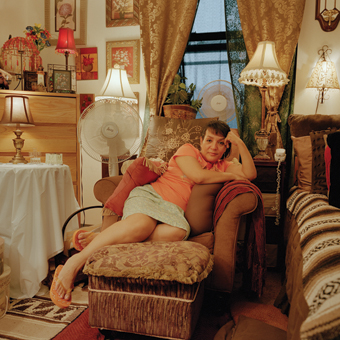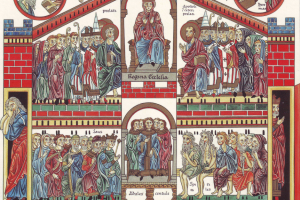After life on the street, there’s nothing like sitting down again at your own kitchen table.
“I never in my life thought that at age 50 I’d be homeless, not in a million years,” says Pam Gorro, looking back now on the series of events that left her living on the streets. Working as a full-time in-home caregiver on Chicago’s North Side, Gorro had a roof over her head and a stable income. But faced with increasing job stress, worsening depression, and the unexpected death of the person she provided care for, Gorro found herself on the streets, without any family to fall back on. “I didn’t know what to do,” she said.
Gorro camped out at the local emergency room until hospital employees called social services. From there Gorro entered a shelter and began a two-year path back to stable housing.
For the next year, Gorro lived in three different emergency shelters across Chicago. “You don’t know what’s out there until you’re on this side of the fence. Being homeless for the first time in your life, you first are getting over the shock, then you’re trying to fit in so you feel a little more comfortable,” Gorro recalls. This was not always easy to do, she says, as many of the shelters were located in some of the city’s tougher neighborhoods, and Gorro often went to sleep hearing gunshots.
A turning point came at Tabitha House, an emergency shelter for women. “I really don’t know what I’d have done if they hadn’t come along,” Gorro says, since Tabitha House helped her gain referrals to programs aimed at placing people into permanent housing.
From Tabitha House, Gorro learned of Deborah’s Place, Chicago’s largest provider of supportive housing for women. She stayed at Teresa’s Interim Housing, a program of Deborah’s Place, for several months before securing the permanent single-occupancy room where she currently lives. Gorro is now able to focus on improving her health and returning to full-time employment.
“Each cycle went up, up, up,” she says. “My steps did not go back, they went up.”
Gorro was one of the many success stories featured in photographer Noah Addis’ “Pathways to Stable Housing” exhibit at Loyola University Museum of Art in Chicago late last year.
“Instead of looking at people actually living on the street, I was curious to look at people who had managed to find housing,” Addis says. “I wanted to show that there can be a good ending, that people who have been homeless can eventually find a better situation.”
Though official estimates of homelessness are difficult to gauge, the National Coalition for the Homeless approximates that around 1.6 million people each year use transitional housing or emergency shelters. The number of people who actually experience homelessness in a given year is likely closer to 3.5 million.
Homelessness can affect anyone—young or old, male or female, black or white, lifelong worker or chronic mental health patient. Some of the most common factors contributing to homelessness, especially during the recent economic recession, include lack of jobs, low wages, lack of health care, and the foreclosure crisis, according to the National Alliance to End Homelessness (NAEH).
Because each person experiences homelessness differently, each person’s path to permanent housing is unique.
Project H.O.M.E., a Philadelphia-based nonprofit organization co-founded by Sister Mary Scullion, O.S.M., works to empower people to break cycles of poverty and homelessness. The organization uses a “continuum of care” to address the various needs of an extremely diverse homeless population.
The first step is still to get people off the street, a task of Project H.O.M.E.’s outreach program. From there the next phases will vary. “For some people, it will be going to a safe haven, some will go to a shelter, some can actually go straight into housing,” explains Sue Smith, vice president of residential and homeless services.
Smith notes that even with every detail of paperwork and finances in proper order, the process for entering permanent housing can take at least two months, though there is no time limit on staying in the housing once it’s obtained.
“The majority of people we work with stay within supportive housing primarily because it’s affordable,” Smith says. “Finding housing nowadays that you can live on from a Social Security check or other mainstream benefits is hard. Even if you are working, a livable wage with benefits is difficult to come by, so it’s hard to find rent that is affordable.”
Housing is typically considered affordable if no more than 30 percent of household income is directed to housing costs. The NAEH estimates that nationwide, 72 percent of households at or below the federal poverty line spend more than 50 percent of their income on rent, meaning that any unanticipated crisis could put their housing in jeopardy.
In Illinois, according to the National Low Income Housing Coalition, the average cost of a two-bedroom apartment is $843, which requires an hourly wage of $16.78 to affordably sustain. Someone working at minimum wage would need two full-time jobs to afford this amount.
Amy Hampton knows that helping people out of homelessness takes more than telling people to get a job. Hampton is program director of Sanctuary Women’s Development Center, a pilot program of Catholic Charities of Oklahoma City, which provides comprehensive services to homeless and low-income women and children.
“If you’re in the shelter and you’re feeling awful about yourself, and they’re telling you go get a job, but all they give you is a pair of jeans that don’t fit and a dirty T-shirt to wear, are you going to get that job?” she asks.
Sanctuary provides food, showers, and medication, as well as long-term assistance such as job training and computer classes, help with outstanding bills, or connections to education opportunities. “We just really find out what the barrier is that has kept them from getting into housing, or what has kept them from being successful at staying there,” says Hampton.
This barrier can be something as seemingly simple as obtaining identification in order to collect benefits or apply for a job. Hampton explains that when a person tries to get an identification card, they will be asked to supply secondary proof of identity such as a birth certificate. Unable to produce a birth certificate, they are sent to get one, only to find they won’t be issued a birth certificate without any other form of identification. “Sometimes when you’re in the middle of a crisis, that’s enough to stop you dead in your tracks,” Hampton says.
All Jose Vazquez, 66, needed to improve his situation was for someone to step in and offer him help. He lived on the streets of downtown Chicago from 1999 to 2003. “There were people roaming around all night that might steal your stuff, or the police might come at night and bother you, wake you up any time of the night or day,” he remembers. “But you survive, you get by.” Vasquez earned some money selling the Chicago Sun-Times, enough to buy food and thrift-store clothing. It wasn’t until Vasquez was approached by an employee of the Department of Human Services (DHS) that he was able to access the resources to get back into housing. DHS placed him in an emergency shelter and worked with him to secure his own apartment, where he has lived since 2005.
Gaining confidence in a positive atmosphere can be as important to overcoming barriers as any wide range of treatment services, as people become more willing to accept tools of empowerment. “Services are not enough,” Hampton says. “We do really simple things like give them honor, give them dignity, give them choices. It doesn’t take a lot to remind someone that they are a person.”
Prior to coming to Deborah’s Place, Gorro’s experience with The Cara Program, which teaches career and job retention skills, helped change her whole mindset about her situation. “Their saying is, ‘You are worthy of the best that life has to offer you,’ ” Gorro recalls. “When you’re homeless, you don’t feel that way. They help bring that back out in you. That was the first time in a long time I felt proud of myself, because I accomplished something.”
Both Gorro and Vasquez acknowledge that in order to improve your situation, you need to want to make the change yourself. “There are organizations to help, like how DHS helped me,” says Vazquez, who now works for the Chicago Coalition for the Homeless advocating for people experiencing homelessness. “But you’ve got to want the help. You can’t just do it on your own.”
Gorro agrees. “It’s a rough road, but if it’s something you want to do, you can definitely do it.”
This article appeared in the July 2012 issue of U.S. Catholic (Vol. 77, No. 7, pages 28-32).
Image: Noah Addis, whose work has appeared in The New York Times, The Wall Street Journal, and Time.













Add comment